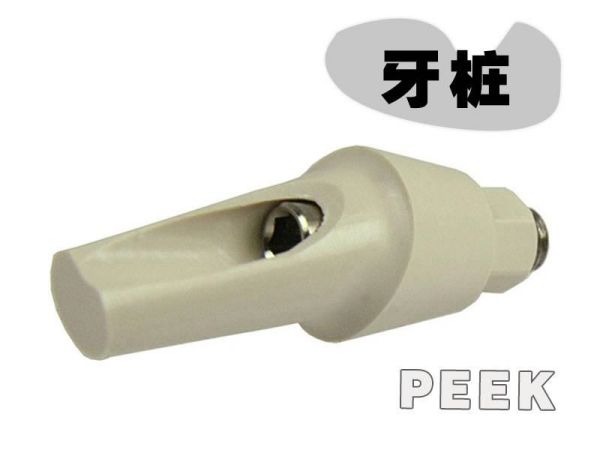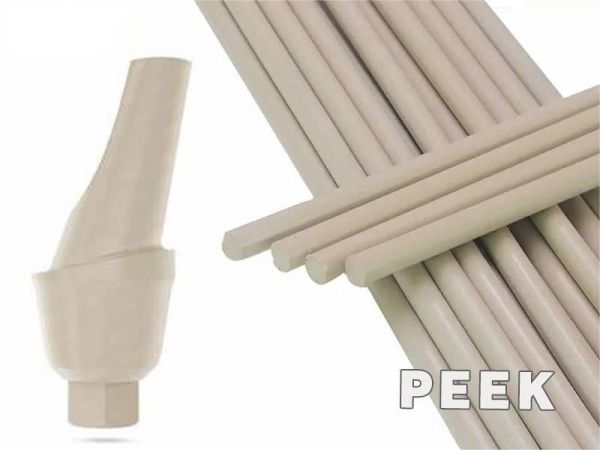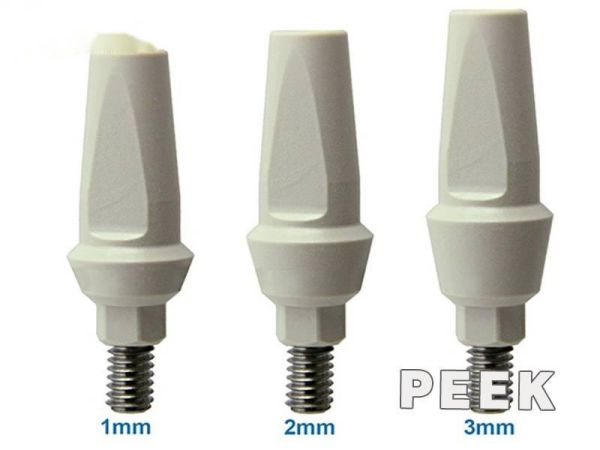
Privacy statement: Your privacy is very important to Us. Our company promises not to disclose your personal information to any external company with out your explicit permission.
The mechanical properties and clinical application of medical-grade engineering plastics-ceramic white PEEK material in dental restorations comply with FDA certification
We all know that dental post and core materials are required to have high fracture and fatigue resistance, accurately match the root canal morphology, and more importantly, have a Young's modulus similar to that of dentin (18.6 GPa). The elastic modulus of the dental post material plays a key role in the stress distribution within the dentin, which in turn affects the fracture performance of the restoration and the tooth. Post materials with a Young's modulus close to that of dentin generally produce a favorable stress distribution, with high stresses on the post and low stresses at the weakened root and post-dentin interface.

Cast metal alloy posts and zirconia posts have a much higher modulus of elasticity than dentin, creating concentrated stresses at the root that may cause root fracture while the post remains intact. Fiber-reinforced composite (FRC) piles exhibit a more balanced stress distribution and, although the risk of root fracture is lower, the piles are more susceptible to fracture.
Nonetheless, due to its excellent mechanical properties, FRC posts have become the most commonly used material for post and core repairs, although there are still some shortcomings. Prefabricated FRC posts cannot match the shape of natural root canals and require specially calibrated drills for root canal preparation, which may increase dentin consumption and cement thickness, thereby increasing the risk of root fractures and post debonding.

Recent results indicate that PEEK exhibits better aesthetics than metal alloys and is comparable to FRC when used as post and core material; its low elastic modulus (3 to 4 GPa) is comparable to that of tooth essence (18.6 GPa), and its GFR -The same is true for the elastic modulus of PEEK (12 GPa) and CFR-PEEK (18 GPa). FEA consistently confirmed the potential of PEEK as an alternative to FRC or fiberglass in post and core repairs. As far as precast piles are concerned, PEEK piles and fiberglass piles showed similar strength and stress distribution in bite load tests, and PEEK piles showed more favorable stress distribution in various structures compared to fiberglass and titanium piles. and failure modes. Whether the restoration and tooth are under mechanical or thermal stress.
Likewise, prefabricated PEEK posts reduced stress concentrations within the post, post cement, and composite core compared to fiberglass posts, while showing no significant effect within the dentin. Carbon fiber and glass fiber can be blended with PEEK to not only increase the stiffness of PEEK but also provide an elastic modulus more similar to dentin, and CFR-PEEK posts exhibit the lowest von in dentin compared to dentin. Mises stress. FRC, GFR-PEEK and polyetherketoneketone columns.

Furthermore, the maximum stress occurred in CFR-PEEK posts and lower stresses were found at the dentin-post interface, suggesting a protective effect conveyed by similar elastic modulus. Regarding the impact of PEEK manufacturing technology, FEA can be used to predict the mechanical behavior of PEEK in post-and-core restorations and to evaluate the accuracy of PEEK manufactured by different methods. It is predicted that the accuracy of hot-pressed PEEK columns will be higher compared to CAD/CAM PEEK columns. The superior performance of PEEK as a post and core material has also been demonstrated in vitro and in vivo. PEEK posts showed the highest fracture resistance compared to polymer-infiltrated ceramic (PIC) posts combined with FRC posts, but tooth fracture outcomes with PEEK were not as good as with FRC. The fracture load of PEEK piles is significantly lower than that of nickel-chromium (NiCr) alloy piles, and it has similar fracture resistance to nanoceramic composite piles and glass fiber piles. Glass fiber piles have the greatest fracture resistance, followed by zirconia piles and PEEK posts, and the fracture load of PEEK posts did not differ significantly when root canal restorations of different sizes were used.

Most PEEK pile failures are due to wear and tear on the pile and core and are repairable. PEEK was tested in flared canals of a bovine tooth model, but PEEK posts were found to have worse mechanical properties than fiberglass posts when repairing flared canals. PEEK is becoming increasingly popular among clinicians as a post and core material because of its excellent aesthetics and mechanical properties. The repair is relatively inexpensive and the results are satisfactory. In conclusion, there is growing evidence for the potential of PEEK as a post and core material, but whether PEEK can improve the long-term survival of teeth and restorations requires further investigation.
LET'S GET IN TOUCH

Privacy statement: Your privacy is very important to Us. Our company promises not to disclose your personal information to any external company with out your explicit permission.

Fill in more information so that we can get in touch with you faster
Privacy statement: Your privacy is very important to Us. Our company promises not to disclose your personal information to any external company with out your explicit permission.